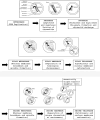Morphological assessment of oocyte quality during assisted reproductive technology cycle
- PMID: 38801314
- PMCID: PMC11349268
- DOI: 10.5935/1518-0557.20240034
Morphological assessment of oocyte quality during assisted reproductive technology cycle
Abstract
Following the advancement of medically assisted reproduction (MAR) technology, and the rationale to extend the culture to the blastocyst stage, performing elective single embryo transfer (eSET), gamete quality and assessment have acquired large relevance in ART. Embryo quality is strictly correlated with gametes quality and culture conditions. Oocyte maturity assessment is therefore imperative for fertilization and embryo evolution. Mature oocytes at the metaphase II stage result in a higher fertilization rate compared to immature oocytes. Indeed, oocyte morphology evaluation represents an important and challenging task that may serve as a valuable prognostic tool for future embryo development and implantation potential. Different grading systems have been reported to assess human embryos, however, in many cases, it is still a major challenge to select the single embryo to transfer with the highest implantation potential. Further, eSET has conferred a challenge to embryologists, who must try to enhance embryo culture and selection to provide an adequate success rate, whilst reducing the overall number of embryos transferred. Above the standard morphological assessment, there are several invasive or non-invasive approaches for embryo selection such as preimplantation genetic testing, time-lapse technology, proteomics and metabolomics, as well as oxygen utilization and analysis of oxidative stress in culture medium. This short review is not designed to be a comprehensive review of all possible features that may influence oocyte quality. It does give, however, a brief overview and describes the prognostic value of the morphological characteristics of human oocytes on their developmental capacity following ART treatments.
Keywords: healthy offspring; medically assisted reproduction; non-invasive assessment; oocyte biomechanical features; oocyte morphology; oocyte quality; pregnancy outcomes.
Figures
Similar articles
-
Oocyte quality and embryo selection strategies: a review for the embryologists, by the embryologists.Panminerva Med. 2022 Jun;64(2):171-184. doi: 10.23736/S0031-0808.22.04680-8. Epub 2022 Feb 18. Panminerva Med. 2022. PMID: 35179016 Review.
-
Reduction of multiple pregnancies in the advanced maternal age population after implementation of an elective single embryo transfer policy coupled with enhanced embryo selection: pre- and post-intervention study.Hum Reprod. 2015 Sep;30(9):2097-106. doi: 10.1093/humrep/dev159. Epub 2015 Jul 5. Hum Reprod. 2015. PMID: 26150408 Free PMC article.
-
Clinical validation of an automatic classification algorithm applied on cleavage stage embryos: analysis for blastulation, euploidy, implantation, and live-birth potential.Hum Reprod. 2023 Jun 1;38(6):1060-1075. doi: 10.1093/humrep/dead058. Hum Reprod. 2023. PMID: 37018626
-
A pre-in vitro maturation medium containing cumulus oocyte complex ligand-receptor signaling molecules maintains meiotic arrest, supports the cumulus oocyte complex and improves oocyte developmental competence.Mol Hum Reprod. 2017 Sep 1;23(9):594-606. doi: 10.1093/molehr/gax032. Mol Hum Reprod. 2017. PMID: 28586460
-
State-of-the-art embryo technologies in cattle.Soc Reprod Fertil Suppl. 2007;64:315-25. doi: 10.5661/rdr-vi-315. Soc Reprod Fertil Suppl. 2007. PMID: 17491156 Review.
Cited by
-
The quality of human eggs and its pre-IVF incubation.Reprod Med Biol. 2025 May 2;24(1):e12652. doi: 10.1002/rmb2.12652. eCollection 2025 Jan-Dec. Reprod Med Biol. 2025. PMID: 40321658 Free PMC article. Review.
-
Reproductive Health and Assisted Conception in Celiac Disease and Non-Celiac Gluten Sensitivity: A Narrative Review.Nutrients. 2025 Jul 3;17(13):2215. doi: 10.3390/nu17132215. Nutrients. 2025. PMID: 40647319 Free PMC article. Review.
References
-
- Barretta M, Cacciottola L, Hossay C, Donnez J, Dolmans MM. Impact of human ovarian tissue manipulation on follicles: evidence of a potential first wave of follicle activation during fertility preservation procedures. J Assist Reprod Genet. 2023;40:2769–2776. doi: 10.1007/s10815-023-02930-9. - DOI - PMC - PubMed
Publication types
MeSH terms
LinkOut - more resources
Full Text Sources
Medical


